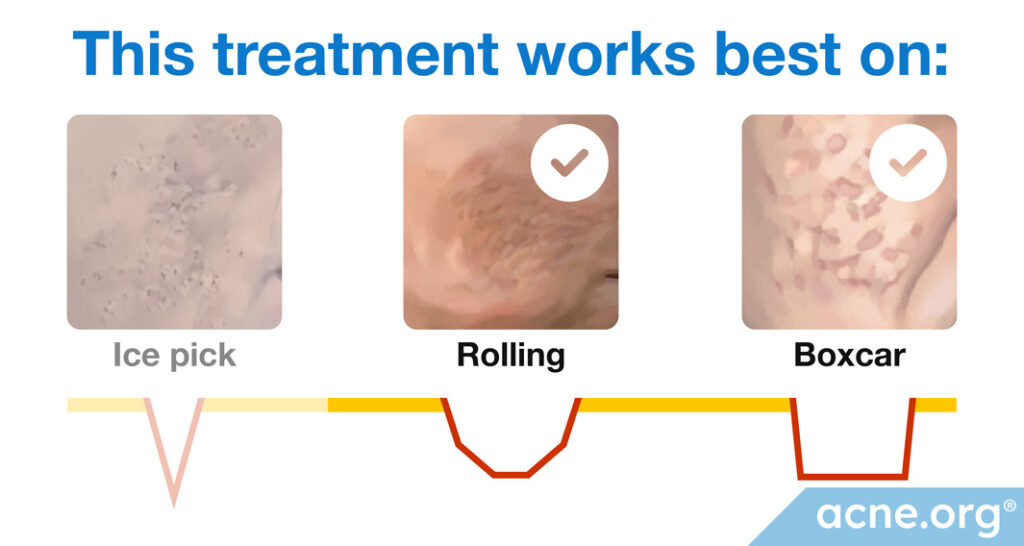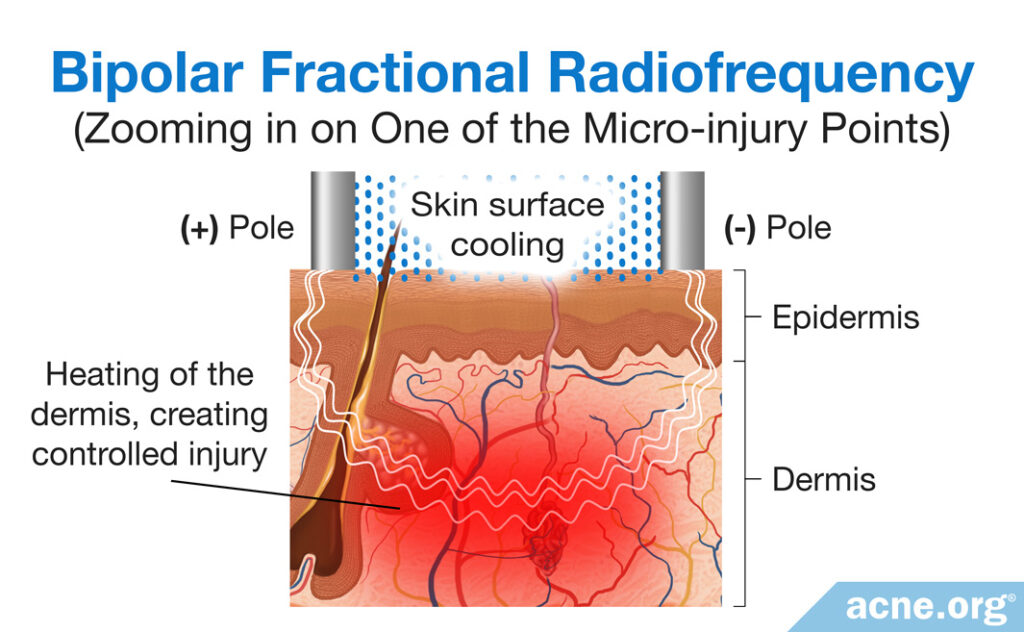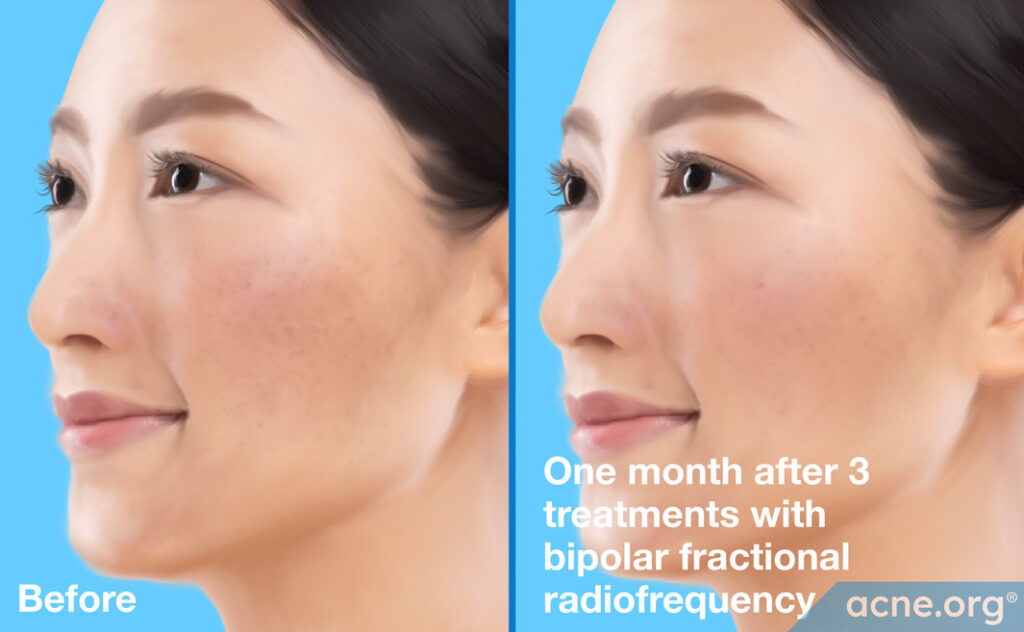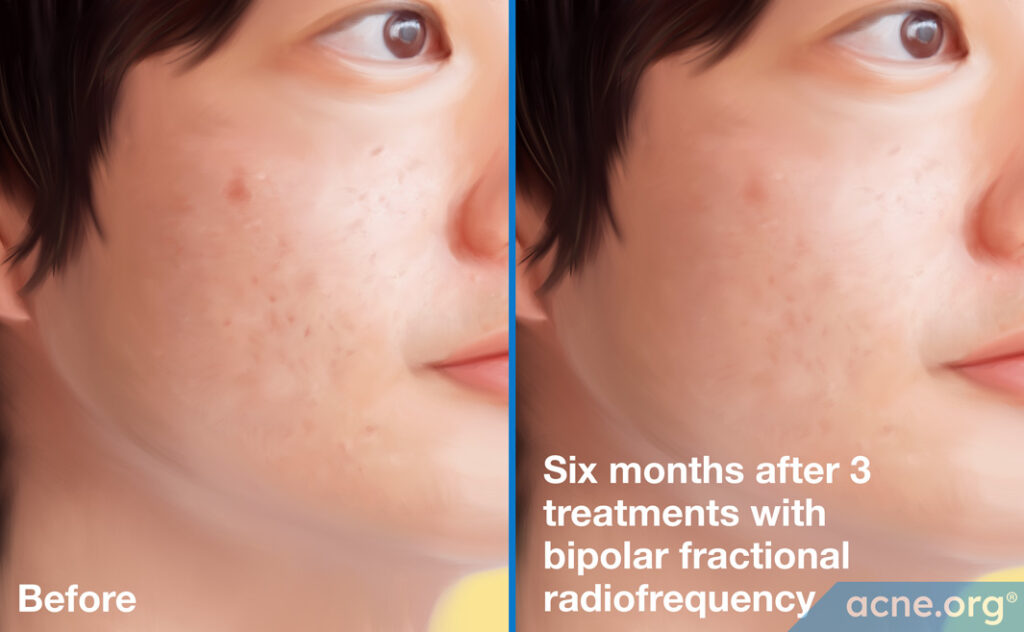
* Bipolar fractional radiofrequency works best on rolling and boxcar scars.
Bipolar fractional radiofrequency is a procedure that uses an array of electrodes that produce controlled microthermal (small bits of heat) injuries to the dermis with scattered areas of unaffected skin in a dot matrix pattern. This provokes a significant dermal wound healing response, resulting in the stimulation of cells that produce collagen and elastin, which contribute to the improvement of acne scars.1,2
Bipolar fractional radiofrequency also goes by other names, including:
- Bipolar Radiofrequency
- Fractional Radiofrequency
- Bipolar RF
- Fractional Bipolar Radiofrequency Microneedling
- Bipolar Fractional Skin Resurfacing
Compared to other scar revision procedures, bipolar fractional radiofrequency has several advantages:
- Nearly painless
- Very short recovery period
- Low risk of side effects
- Higher safety profile in darker skin types3
On the other hand, bipolar fractional radiofrequency has some disadvantages:
- Sometimes not as effective as other scar revision treatments
- Can take weeks or months to start seeing results
As with all scar revision treatments, bipolar fractional radiofrequency is sometimes combined with other scar revision procedures to achieve desired results.
Normally, people with active acne should not undergo acne scar repair of any kind. However, some data is showing that bipolar fractional radiofrequency may clear up acne at the same time that it treats scars, so it may be an exception to this rule.4,5
Before agreeing to undergo bipolar fractional radiofrequency, ask multiple medical professionals about their opinions, proposed treatments, expected outcomes, and prices.
Procedure details:

In bipolar fractional radiofrequency, a medical professional uses a device with a specific delivery system with two electrodes (thus the term “bipolar”) moved across the patient’s skin, allowing the penetration of radiofrequency energy to the dermis (the second, deeper layer of the skin). Radiofrequency energy is delivered directly and primarily to the dermis of the targeted areas affected with acne scars while other parts of the skin are left untouched. By heating the skin dermis, bipolar fractional radiofrequency treatment stimulates collagen production and promotes the formation of tighter, firmer, and more even skin.2,6,7
A doctor or dermatologist typically conducts fractional bipolar radiofrequency.
Bipolar fractional radiofrequency treatment allows precise targeting of the tissue that should be treated but it does not penetrate into deep skin layers, which is why it is mostly used for more superficial treatments, such as skin tightening and fine wrinkle reduction.8 However, because it does stimulate collagen and elastin production in the dermis, it can also be used for mild-to-moderate acne scar treatment.
Delivery systems may vary between bipolar fractional radiofrequency devices. The most commonly used for acne scars are pen-like handpieces that allow precise and controlled application of bipolar radiofrequency energy.

A medical professional moves a bipolar fractional radiofrequency device over a patient’s skin
Anesthesia:
At a medical office: Before fractional bipolar radiofrequency treatment, your physician will probably apply a topical anesthetic, such as a cream containing the numbing drug lidocaine to your skin 30 to 60 minutes before beginning the treatment. In some cases, your doctor might also apply a topical antibiotic 30 minutes before the treatment.1,3
Before-and-after:

Acne scars before and 1 month after 3 treatments with bipolar fractional radiofrequency.

Acne scars before and 6 months after 3 treatments with bipolar fractional radiofrequency.
References
- Eubanks, S. W., & Solomon, J. A. Safety and efficacy of fractional radiofrequency for the treatment and reduction of acne scarring: a prospective study. Lasers in Surgery and Medicine, 54(1), 74-81 (2022).
- Kaminaka, C., Furukawa, F., & Yamamoto, Y. Long-term clinical and histological effects of a bipolar fractional radiofrequency system in the treatment of facial atrophic acne scars and acne vulgaris in Japanese patients: a series of eight cases. Photomedicine and laser surgery, 34(12), 657-60 (2016).
- Forbat, E., & Al-Niaimi, F. Fractional radiofrequency treatment in acne scars: Systematic review of current evidence. Journal of Cosmetic and Laser Therapy, 18(8), 442-7 (2016).
- Kaminaka, C., Uede, M., Matsunaka, H., Furukawa, F., & Yamamoto, Y. Clinical studies of the treatment of facial atrophic acne scars and acne with a bipolar fractional radiofrequency system. The Journal of Dermatology, 42(6), 580-7 (2015).
- Min, S., Park, S. Y., Yoon, J. Y., & Suh, D. H. Comparison of fractional microneedling radiofrequency and bipolar radiofrequency on acne and acne scar and investigation of mechanism: comparative randomized controlled clinical trial. Archives of dermatological research, 307, 897-04 (2015).
- Mazloom, S., & Sadick, N. Efficacy of radiofrequency technology in the treatment of aesthetic indications. Journal of Aesthetic Nursing, 7(7), 364-72 (2018).
- Nitayavardhana, S., Wanitphakdeedecha, R., Ng, J. N. C., Eimpunth, S., & Manuskiatti, W. The efficacy and safety of fractional radiofrequency nanoneedle system in the treatment of atrophic acne scars in Asians. Journal of cosmetic dermatology, 19(7), 1636-41 (2020).
- Martin, J. C., Dokic, Y., Munavalli, G., & Malone, C. H. Bipolar fractionated radiofrequency midface lift: A retrospective review. Journal of Cosmetic Dermatology, 21(1), 268-70 (2022).
- Harmelin, Y., Boineau, D., Cardot‐Leccia, N., Fontas, E., Bahadoran, P., Becker, A. L., & Passeron, T. Fractionated bipolar radiofrequency and bipolar radiofrequency potentiated by infrared light for treating striae: A prospective randomized, comparative trial with objective evaluation. Lasers in surgery and medicine, 48(3), 245-53 (2016).
- Rongsaard, N., & Rummaneethorn, P. Comparison of a fractional bipolar radiofrequency device and a fractional erbium-doped glass 1,550-nm device for the treatment of atrophic acne scars: a randomized split-face clinical study. Dermatologic surgery, 40(1), 14-21 (2014).
- Verner, I. Clinical evaluation of the efficacy and safety of fractional bipolar radiofrequency for the treatment of moderate to severe acne scars. Dermatologic therapy, 29(1), 24-7 (2016).
 Acne.org Products
Acne.org Products